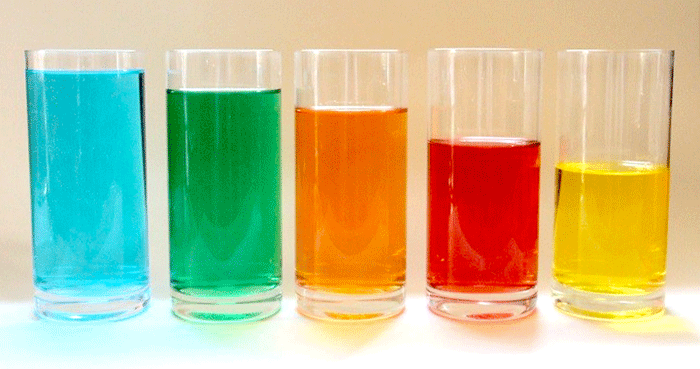|
 |
We’ve all heard the clinking sound that glass makes when glasses bump into each other or when a spoon taps against the side of a glass. This clinking sound varies with the glass and with what’s in the glass. You can easily investigate this sound and make some discoveries about what affects the sound.
|
PART ONE |
For the first part of this investigation, all you need is:
- one glass container that holds at least 16 ounces, such as a drinking tumbler or a glass jar
- a spoon
- a pitcher that holds more than the glass
- water to fill the pitcher
- a towel to mop up spills
|
Procedure:
- Start by placing the empty glass on a waterproof surface, like the kitchen counter. Gently tap with the spoon on the side of the glass near the rim and listen to the sound it makes.
- Pour water into the glass until it is about one-quarter full. Tap the side of the glass again. Has the sound changed?
- Pour more water into the glass until it is about half full. Again tap the side of the glass. Has the sound changed from before? How is the sound changing as you put more water into the glass?
- Pour more water into the glass until it is about three-quarters full. Predict what will happen to the sound when you tap the side of the glass. Tap the glass. Is this what you expected?
- Predict what will happen to the sound when you nearly fill the glass with water. Try it. Is what you predicted what you observed?
|
As more water is put into the glass, the sound changes. The difference in the sound is called its pitch. A large bell has a low pitch and a small bell has a high pitch. Does the pitch of the sound go up or down as water is added to the glass? Just as a big bell has a lower-pitched ring than a smaller bell, the glass with more water has a lower-pitch sound than the glass with less water. The greater mass of a bigger bell gives it a lower pitch than the lesser mass of a smaller bell. Similarly, the greater mass of more water gives the glass a lower pitch than when it contains a lesser mass of water. |
DOESN’T PITCH GO UP WHEN YOU POUR WATER INTO A GLASS?
|
PART TWO |
In this part, we will repeat the process of Part One, but instead of filling the glass by quarters, we will fill it in smaller increments. Now we will try to observe how the pitch changes with each increment.
|
This part uses the same materials as Part One, but adds also:
- a tablespoon measure
- a bowl that holds more water than the glass
|
Procedure:
- Fill the bowl with water.
- Tap the side of the empty glass and listen to the sound it makes.
- Transfer 2 tablespoons of water from the bowl into the glass and tap it again. Did the sound change?
- Add 2 more tablespoons of water to the glass and tap the glass. How has the pitch changed?
- Repeat the previous step until the glass is nearly full. Does the pitch change more when a little water is added to the nearly empty glass or when a little water is added to the nearly filled glass?
|
The pitch of the sound changes very little, if at all, when a small amount of water is added to a nearly empty glass. The pitch changes much more when water is added to a nearly full glass. When you tap the side of the glass, you put energy into the glass and its contents. This energy causes the glass and its contents to vibrate. You may be able to see tiny waves form in the surface of the water when you tap the side of the glass. Vibrations in the water cause these waves.
The pitch of a sound is determined by the frequency of the vibration that causes the sound. In this experiment, the frequency of the vibration is determined by the mass of the water in the glass. As the mass of water in the glass increases, the frequency of the vibration goes down. When the glass is nearly empty, the vibration is fast and the pitch of the sound is high. When the glass is nearly full, the vibration is slower, and the pitch of the sound is lower. It takes more water to make a perceptible change in pitch at high frequencies than it does at low frequencies. |
A MORE DETAILED EXPLANATION
|
PART THREE |
We’ve observed how adding water to a glass container lowers the pitch of the sound it makes when the glass is tapped. In this part we will use this observation to create a musical instrument. The materials you will need are:
- five identical glass containers
(thin-walled containers make the most pleasing sound)
- a spoon
- a pitcher for water
- a scale accurate to 2 grams (or to 0.1 ounce)
- food coloring (optional)
|
Procedure:
- Fill one of the glasses to nearly full with water. Measure the mass of the water in the glass. You can do this by measuring and recording the mass of the glass and water, pouring the water into another container, and measuring and recording the mass of the empty glass. Pour the water back into the glass.
| The mass of the water is found by subtracting the mass of the empty glass from the mass of the glass and water. For example: |
| mass of glass and water |
692 grams |
mass of empty glass |
277 grams |
mass of water |
415 grams |
- Calculate the mass of water that corresponds to 92% of the water in the first glass. (For example, 92% of 415 grams is 0.92 times 415, which is 382 grams.) Put your calculated mass of water into the second glass.
- Calculate the mass of water that corresponds to 82% of the water in the first glass. Put this mass of water into the 3rd glass.
- Calculate the mass of water that corresponds to 66% of the water in the first glass and put this into the 4th glass.
- Calculate 53% of the mass of water in the first glass and put this into the fifth glass.
- Tap the side of each glass and listen to the sounds. Can you play a melody on these glasses?
Suggestion: Number the glasses 1 to 5.
Try tapping the glasses in this order:
3-2-1 2-3-3-3, 2-2-2, 3-5-5.
Does that sound familiar?
|
 |
If you want to make the glasses more visually attractive, you can add a drop of food coloring to the water and stir the mixture. If you like, you may use different colors in different glasses. The glasses in the picture are a set made by following the instructions in Part 3.
The five pitches that are produced in this arrangement form a pentatonic scale. Many traditional folk tunes use the pentatonic scale. The pitches produced by the instructions here may not be the most pleasing version of the pentatonic scale, because different glasses have different effects on the pitches. The percentages used in the directions are an average of the amounts needed in several different kinds of glasses. Your glasses may be different, and so, give pitches that are a little “off.” That is why the song you hear when following the directions above may sound a little strange. Each of the pitches can be adjusted by adding water (to lower the pitch) or removing water (to raise the pitch). You may want to tune your set of pitches to produce a more attractive combination. You can also use more glasses to make a musical instrument with more pitches, so you can play songs that use more than five pitches. |


